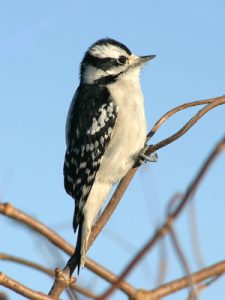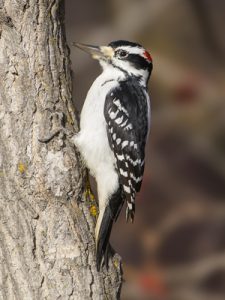Downy and Hairy Woodpeckers
 Guest blog contribution from Steven Price, President, Birds Studies Canada.
Guest blog contribution from Steven Price, President, Birds Studies Canada.
Downy and Hairy woodpeckers can be seen in gardens across Canada, north to the tree line. They are similar in appearance, but with practice, you’ll distinguish them by overall size and bill length.
Both species are beautifully patterned black and white, with males having a small red patch on the back of the head. The pictures are of a female Downy and a male Hairy. For both species, look for a bold white stripe down the back.
Beware: a woodpecker with a long white stripe on the wing is a sapsucker, and one with a full red hood is a Red-headed Woodpecker. (Misidentifying male Downies or Hairies as ‘Red-headed Woodpecker’ is a common mistake.)
Other woodpeckers aside, how do we distinguish Downies from Hairies?


Downy Woodpecker (female) Hairy Woodpecker (male)
Photo Credit: Ron Ridout Photo Credit: May Haga
Everything about the Downy is smaller and gentler. If it’s as big as a robin, it’s a Hairy; smaller is a Downy. Hairies have a strong, heavy bill, about as long as the head is deep. Downies have a much smaller bill, just a third of the head depth. Before long, you’ll see the difference at a glance!
Downies are one of the most likely woodpeckers to come to feeders, and possibly the only woodpecker you’ll attract with seeds alone. In most of Canada, a suet cake of almost any recipe, homemade or purchased, will eventually attract a couple more woodpecker species.
I see more Downies than Hairies in the garden. The Downy will search for insects on smaller branches of trees and even shrubs, or peck at a plant gall, like those spheres you see on goldenrod plants. They also tap on my board-and-batten house, without doing any damage. Hairy Woodpeckers favour larger trees and forested areas, but I see them at my seed and suet feeders occasionally.
Woodpeckers are always fascinating, and a great way to introduce kids and neighbours to birds in your garden, at your cottage, or on the farm.
Bird Studies Canada
Steven Price
President



